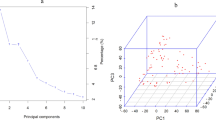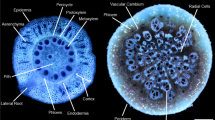Abstract
The phosphorus efficiency, relative biologic characteristics and relative root exudations as well as the quantitative trait loci associated with these traits were determined for an F2:3 population derived from the cross of two contrasting maize (Zea mays L.) genotypes, 082 and Ye107. A total of 241 F2:3 families were evaluated in replicated trials under normal phosphorus (50 kg P/ha) and low phosphorus (0 kg P/ha) conditions in 2007 at two sites (Kaixian and Southwest University). The genetic map constructed by 275 SSR and 146 AFLP markers spanned 1,681.3 cM in length with an average interval of 3.84 cM. The heritability of PE, PAE, RPH, RBW, RRW, RLA, TPS, RTW, RFN, RAP and RH was all high (\(h_{\text{b}}^2 > 60\% \)) whereas the heritability of root exudations was all low (\(h_{\text{b}}^2 > 60\% \)).By using composite interval mapping (CIM), a total of 30 and 45 distinct QTLs were identified at Kaixian and Southwest University. At two sites, the number of same QTL located on common region was 16, five for PE (bins 1.07, 4.09, 5.05, 5.07, 5.08), three for RBW (bins 3.04, 5.04, 6.05), three for RRW (bins 5.05, 5.06, 5.07), one for RLA (bins 3.04), two for TPS (bins 3.08, 5.07), two for RTW (bins 5.05, 5.06). These QTLs explained 21% of the phenotypic variation of PE, 5–9% of RBW, 13–16% of RRW, 9% of TPS, 7% of RTW, respectively. The 16 common QTLs displayed mostly partial dominance or over-dominance gene action. Most QTL alleles conferring high values for the traits came from two parents. Mapping analysis identified chromosomal regions associated with two or more traits in a cluster, which was consistent with correlation among traits. The result showed either pleiotropy or tight linkage among QTL. Five common regions for same QTL at different site were found in the interval bnlg1556-bnlg1564 (bins 1.06), mmc0341-umc1101 (bins 4.08), mmc0282-phi333597 (bins 5.05), bnlg1346-bnlg1695 (bins 5.07) and bnlg118a-umc2136 (bins 5.08), which were important for PE. The information reported in the present paper may be useful for improving phosphorus efficiency by means of marker-assisted selection.



Similar content being viewed by others
References
Bassam BJ, Caetano AG, Gresshof PM (1991) Fast and sensitive silver staining of DNA in polyacrylamide gels. Ann Biochem 196(1):80–83
Bates TR, Lynch JP (2001) Root hairs confer a competitive advantage under low phosphorus availability. Plant Soil 236:243–250
Bhadoria PBS, Singh S Claassen N (2001) Phosphorus efficiency of wheat, maize and groundnut grown in low phosphorus supplying soil. In: Horst WJ, Schenk MK, Bürkert A (eds) Plant nutrition - food security and sustainability of agro-ecosystems. Kluwer Academic Publishers, Dordrecht, pp. 530–531
Blum A (1997) Constitutive traits affecting plant performance under stress. In: Edmeades GO, Bänziger M, Mickelson RHR, Peña Valdivia CB (eds) Developing drought and low-N tolerance maize. CIMMYT, El Batan, pp. 131–135
Boero G, Thien S (1979) Phosphatase activity and phosphorus availability in the rhizosphere of corn roots. In: Harley JL, Russell L (eds) Soil–root interface. Academic, London, pp 231–242
Da Silva AE, Gabelman WRH, Coors JG (1992) Inheritance of low-P tolerance in maize grown in a sand–alumina culture medium. Plant Soil 146:189–197
Davis GL, McMullen MD, Baysdorfer C, Musket T, Grant D, Staebell M, Xu G, Polacco M, Koster L, Melia-Hancock S, Houchins K, Chao S, Coe EH Jr. (1999) A maize map standard with sequenced core markers, grass genome reference points and 932 expressed sequence tagged sites (ESTs) in a 1736- locus map. Genetics 152:1137–1172
Giuliani MM, Darrah LL, Salvi S, Sanguineti MC, Landi P, Conti S, Tuberosa R (2000) Comparative QTL analysis in maize for vertical root PUEling resistance in the field and root traits in hydroponics. Abstracts of the ‘Plant & Animal Genome VIII’ Conference, 9–12 January, San Diego, CA, pp. 114
Guingo E, Hebert Y (1997) Relationships between mechanical resistance of the maize root system and root morphology and their genotypic and environmental variation. Maydica 42:265–274
Guingo E, Hebert Y, Charcosset A (1998) Genetic analysis of root traits in maize. Agronomie 18:225–235
Hinsinger P (2001) Bioavailability of soil inorganic P in the rhizosphere as affected by root-induced chemical changes: a review. Plant Soil 237:173–195
Jenison JR, Shank DB, Penny LRH (1981) Root characteristics of 44 maize inbreds evaluated in four environments. Crop Sci 21:233–237
Jones DL, Darrah PR (1995) Influx and efflux of organic acids across the soil–root interface of Zea mays L. and its implications in rhizosphere C flow. Plant Soil 173:103–109
Kaeppler SM, Parke JL, Mueller SM, Senior L, Stuber C, Tracy WF (2000) Variation among maize inbred lines and detection of quantitative trait loci for growth at low phosphorus and responsiveness to arbuscular mycorrhizal fungi. Crop Sci 40, 358–364
Landi P, Albrecht B, Giuliani MM, Sanguineti MC (1998) Seedling characteristics in hydroponic culture and field performance of maize genotypes with different resistance to root lodging. Maydica 43:111–116
Landi P, Giuliani MM, DaRFNah LL, Tuberosa R, Conti S, Sanguineti MC (2001) Variability for root and shoot traits in a maize population grown in hydroponics and in the field and their relationships with vertical root pulling resistance. Maydica 46:177–182
Landi P, Salvi S, Sanguineti MC, Stefanelli S, Tuberosa R (2002) Development and preliminary evaluation of near-isogenic maize lines differing for a QTL which affects leaf ABA concentration. Maize Genet Coop News Lett 76:7–8
Lebreton C, Lazic-Jancic V, Steed A, Pekic S, Quarrie SA (1995) Identification of QTL for drought responses in maize and their use in testing causal relationships between traits. J Exp Bot 46, 853–865
Lee M, Sharopova N (2002) Expanding the genetic map of maize with the intermated B73 × Mo17(IBM) population. Plant Mol Biol 48:453–461
Liu D, Coloe S, Baird R, Pedersen J (2000) Rapid mini-preparation of fungal DNA for PCR. J Clin Microbiol 38(1):471
Rehner S, Bledsoe C, Mueller G et al (1989) Exaction of DNA from basidiomycetes for ribosomal DNA hybridization. Can J Bot 67:1235–1243
Sharopova N, McMullen MD et al (2002) Development and mapping of SSR markers for maize. Plant Mol Biol 48:463–481
Stam P (1993) Construction of integrated genetic linkage maps by means of a new computer package: JoinMap. Plant J 3:739–744
Stuber CW, Edwards MD, Wendel JF (1987) Molecular marker-facilitated investigations of quantitative traits loci in maize. II. Factors influencing yield and its component traits. Crop Sci 27:639–648
Tabatabai MA, Bremmer JM (1969) Use of p-nitrophenyl phosphate for assay of soil phosphatase activity. Soil Biol Biochem 1, 301–307
Tuberosa R, Parentoni S, Kim TS, Sanguineti MC, Phililips RL (1998a) Mapping QTLs for ABA concentration in leaves of a maize cross segregating for anthesis date. Maize Genet Coop News Lett 72:72–73
Tuberosa R, Sanguineti MC, Landi P et al (1998b) RFLP mapping of quantitative trait loci controlling abscisic acid concentration in leaves of drought-stressed maize (Zea mays L.). Theor Appl Genet 97:744–755
Tuberosa R, Sanguineti MC, Landi P, Giuliani MM, Salvi S, Conti S (2002) Identification of QTLs for root characteristics in maize grown in hydroponics and analysis of their overlap with QTLs for grain yield in the field at two water regimes. Plant Mol Biol 48:697–712
Tuberosa R, Salvi S, Sanguineti MC et al (2003) Searching for quantitative trait loci controlling root traits in maize: a critical appraisal. Plant Soil 255:35–54
Zhu J, Lynch JP (2004) The contribution of lateral rooting to phosphorus acquisition efficiency in maize (Zea mays L.) seedlings. Funct Plant Biol 31:949–958
Zhu J, Kaeppler SM, Lynch JP (2005a) Mapping of QTL controlling root hair length in maize (Zea mays L.) under deficient phosphorus. Plant Soil 270:299–310
Zhu JM, Mickelson SM, Kaeppler SM et al (2005b) Detection of quantitative trait loci for seminal root traits in maize (Zea mays L.) seedlings grown under differential phosphorus levels. Theor Appl Genet 113(1):1–13
Zhu JM, Kaeppler SM, Lynch JP (2006) Mapping of QTLs for lateral root branching and length in maize (Zea mays L.) under differential phosphorus supply. Theor Appl Genet 111(4):688–695
Acknowledgements
This research was funded by funds by the Chongqing key scientific and technological project “Elite Variety Renovation of Rice and Maize”(CSTC2007AB1045).
Author information
Authors and Affiliations
Corresponding author
Additional information
Responsible Editor: Tim Simon George.
Junyi Chen and Li Xu contributed equally to this work.
Rights and permissions
About this article
Cite this article
Chen, J., Xu, L., Cai, Y. et al. QTL mapping of phosphorus efficiency and relative biologic characteristics in maize (Zea mays L.) at two sites. Plant Soil 313, 251–266 (2008). https://doi.org/10.1007/s11104-008-9698-x
Received:
Accepted:
Published:
Issue Date:
DOI: https://doi.org/10.1007/s11104-008-9698-x




